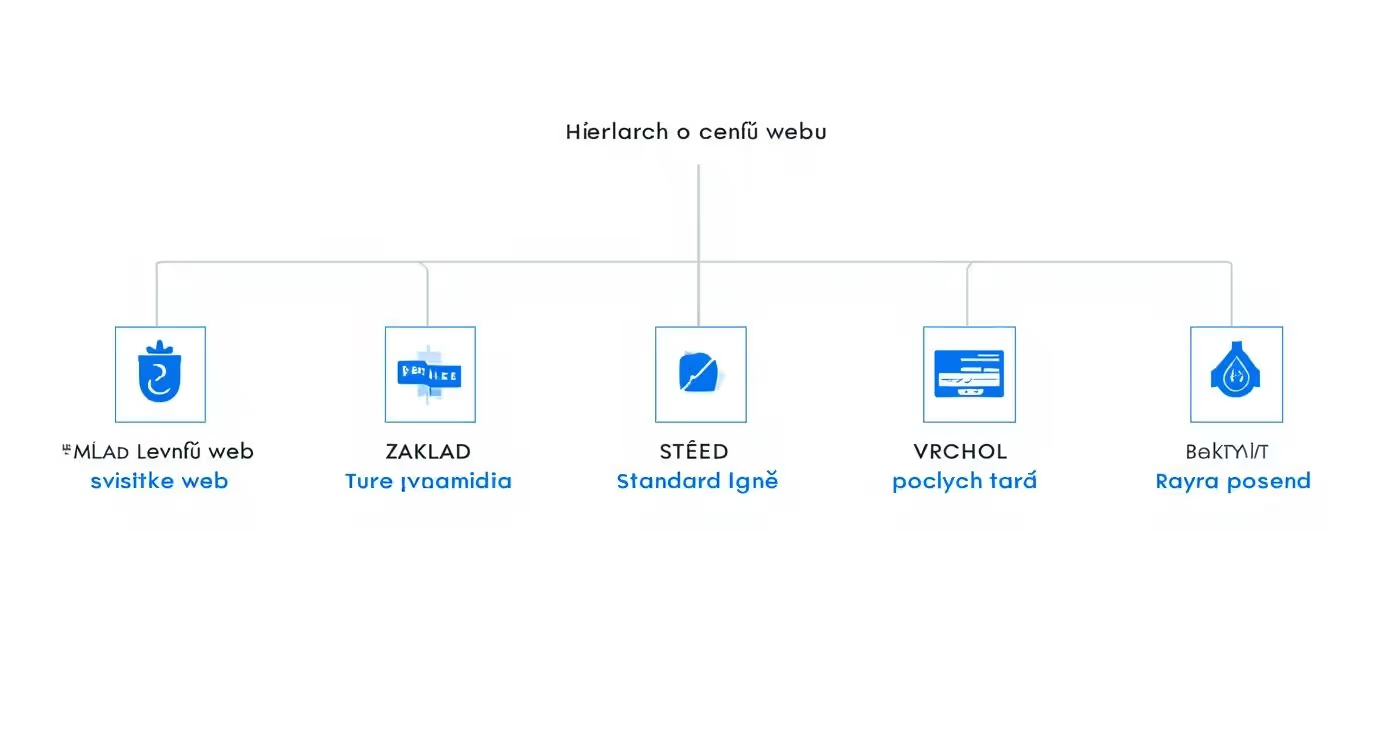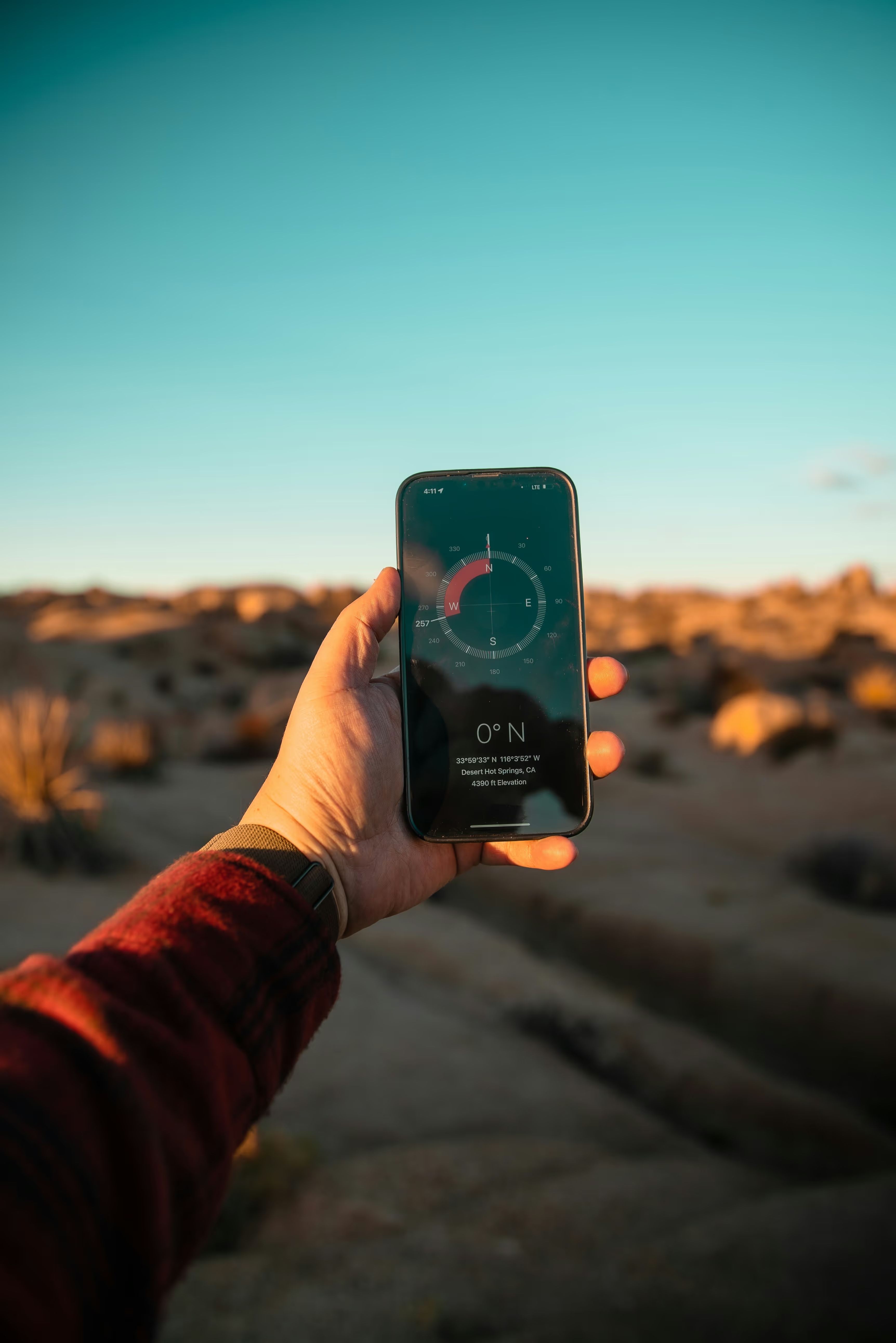Asking for average price of the site is a bit like asking about the average price of a car. Depends if you're looking for an older Fabia for a drive or a brand new SUV with full gear. In general, we can say that a simple website will cost you about 15 000 CZKwhile more complex projects are playfully swung over 100 000 CZK. In short, the differences are huge and it all depends on the details.
How much does a website really cost in the Czech Republic
Let's take a look at specific numbers without unnecessarily walking around hot porridge. There is no magic amount that applies to everyone. The right question is not, “How much does the website cost? “, but more like “What exactly do I get for my money? “. Your investment will depend on what you want, where you're headed, and how technically complex it will be.
The modern web has long been not just a digital business card, quietly lying somewhere. It's your tireless marketer, a powerful marketing channel, and often the very first place a customer encounters your brand. Thus, the price logically reflects the depth of the strategy, the quality of the design and all those features that you need to achieve your goals.
Overview of typical price levels
To give you a better idea, let's break down the market into several basic categories. Each of them sits on a different need and a different ambition. It's not about finding the cheapest option, but the one that makes sense for you.
- Basic website (approx. 15 000 — 30 000 CZK): In this price list, we are most often talking about a simple, even one-page presentation built on a ready-made template. It is an ideal start for entrepreneurs, local cafes or as a quick test of a new business idea.
- Standard company website (approx. 30 000 — 80 000 CZK): Here we are already entering the world of honest, multi-page websites with tailored design, well-thought-out structure and basic search engine preparation. The perfect solution for small and medium-sized companies that want to operate professionally and actively attract new demand.
- Advanced and complex projects (over CZK 80,000): This group includes large corporate portals, tailor-made e-shops, websites with reservation systems or with connections to internal systems such as CRM or invoicing. The investment here fully corresponds to the high degree of individualization and automation of processes.
The key to success is to look at the web not as a load, but as an investment. A cheap website that does not bring you a single customer, as a result, is much more expensive than a professional solution, the price of which will return you several times in new orders.
Now let's look at a more clear table that will help you quickly navigate.
Indicative price range of websites in the Czech Republic
This table provides a quick overview of typical price levels for different types of web projects, from basic to large-scale.
Web typeTypical price range (CZK) For whom it is suitableA one-page website (called. “One-page”)15 000 — 25 000 CZK Entrepreneurs, small local services, portfolioBasic company presentation25 000 — 50 000 CZKSmall and medium-sized enterprises (SMEs), restaurants, artisansTailor-made website with specific features50 000 — 120 000 CZK Companies with the need for unique design and functionalitiesSmall bespoke e-shop80 000 — 200 000 CZKBeginning online retailers, specialty storesExtensive portal or comprehensive e-shop200 000 CZK and moreLarge companies, specialized online services, e-shops with thousands of products
Take these numbers as a springboard. The final price will always depend on the specific requirements of your project.
What affects the price the most
It's good to know that even within these categories, prices can vary significantly. According to the analysis of the Czech market, the price of a standard corporate website moves most often between 30,000 and 80,000 CZK, which just confirms how much it depends on a particular assignment.
If you want to delve deeper into the numbers, I recommend taking a walk this detailed survey on website pricing in the Czech Republic on Webfusion.cz. This overview will give you a great basic orientation and help you better assess the offers you get on the table. This way you will know exactly what you can and should expect with your money.
What really makes up the final price of your website
Think of the price of a site as a jigsaw puzzle. It is not just one large number, but the sum of many smaller, interconnected pieces. Every decision you make, from the visual form to the final button, adds another piece to the mosaic and thus affects the overall investment. Understanding what lies behind the numbers is key. Only then will you know exactly what you are paying for and where the real value is created.
Many think they only pay to “code” pages. But the truth is much more colorful. The prize includes strategic thinking, creative design, technical implementation, and often the creation of content that will actually sell. So let's break down the most important pieces that compose average website price.
Design and User Experience (UX)
One of the first and biggest milestones is the choice between a ready-made template and a custom-made design. And believe me, it's not just a matter of “making it look nice”, but above all of the functionality and uniqueness of your digital imprint.
- Template (cheaper option): It's like buying a ready-to-wear suit. It's quickly available, significantly cheaper and absolutely great for a lot of purposes. But you have to put up with its cut, color and limited editing options.
- Tailor-made design (more expensive option): Here you have the suit sewn exactly according to your measurements. Every detail, from the layout to the smallest animation, is designed to fit perfectly with your brand and guide the customer exactly where you need to go. This path requires in-depth work on the user experience (UX) and interface (UI), which is an arduous process. But the results are worth it.
Investing in custom design will pay off in the form of higher conversions and more satisfied customers, because the site is natural, intuitive and just works for them.
A bespoke website is not a luxury, but a strategic investment. It is a tool designed to fulfill specific business objectives, not just passively exist on the Internet.
Functions and technical complexity
Each feature is like an extra room in your digital home — increasing its value, but also the cost of construction. A simple web-based business card of a few pages can be relatively inexpensive. But as soon as you start adding more complex elements, the price logically climbs up.
Some of the most common “add-on” features that take the project further include:
- E-shop functionality: It's not just a basket and payment gateways. You have to deal with product management, warehouses, orders and logistics.
- Booking systems: A must for hotels, restaurants, doctors or consultants.
- Connection to external systems (APIs): Connecting the site to your CRM, accounting software (e.g. Facturoid) or an emailing tool (such as Mailchimp) saves time and reduces error rate. It's the brain of the whole operation.
- Multilingualism: Translations and technical implementation of other language versions represent additional extra work.
- Advanced animations and interactivity: The unique visual effects can be overwhelming, but behind them are dozens of hours of development.
This infographic clearly shows how projects are divided by complexity and price from basic solutions to advanced systems.

The pyramid clearly illustrates a simple rule: the higher you aim with features and originality, the more investment to expect.
Content creation and copywriting
An often underestimated but absolutely crucial factor is content. You can have the most beautiful website in the world, but if there are not strong and convincing words on it, you will not gain customers. An empty house does not amaze anyone.
He's professional Copywriting is not just about writing without errors. It's the art of selling your services with words that resonate with your target audience and gently guide it to action. It also includes SEO Optimization of Textsso that people can find you in search engines at all. While delivering your own texts can reduce the initial price, investing in a copywriter almost always pays off many times over. Because it ultimately sells quality content, not just pretty pictures.
How time and experience translate into your website budget
Behind every great site that works like a well-lubricated machine, there are dozens, and sometimes hundreds of hours of honest work by talented people. It is absolutely crucial to understand how their time and experience will translate into the final prize. You don't just pay for code and images. You pay for the expertise, creativity and strategy that will truly move your business forward.
Think of it as building a house. You need an architect (UX/UI designer) to design a space where you feel great and everything makes sense. Then a builder (programmer) who converts the plans into a solid wall and a functional roof. And finally someone with a sense of detail (copywriter) who breathes the soul into the house and makes it a home where people like to return. Each of them has its value, years of experience and its rate.

Freelancer, studio, or big agency? Who is right for you
One of the most crucial decisions that will affect your budget is choosing a partner. Each path has its pros and cons and lends itself to a completely different type of project or phase of your business.
- Freelancer (independent specialist): Often this is the most affordable option. Communication is direct, fast and flexible. Perfect for smaller projects such as simple corporate sites or “one-page” sites, where you can get by with the skills of one, maximum two skilled people.
- Small studio: Here you already have at your disposal a team of a couple of specialists who together cover everything from design to development. They offer you a more personal approach than a corporate agency, but at the same time more certainty and scope than an individual. A great golden mean for medium sized projects.
- Large Agency: It has a comprehensive team of experts on everything you can think of — from strategists and analysts to SEO wizards to project managers. They can handle even the most complex and largest projects. Logically, however, comes a higher price, reflecting their operating costs and breadth of services.
There is no “best” answer. The goal is to find a partner whose size, work style and focus fits perfectly with your ambitions and budget.
What really lies behind the hourly rate
The hourly rate is not just some number. It hides every course, every book read, every night spent on a project. It reflects years of experience, constant education, investment in expensive tools and, most importantly, the ability to solve problems quickly and efficiently.
An experienced pro can master in an hour what a junior learns all day. So you're not paying for time spent at the computer, but for speed, quality, and avoiding costly mistakes and dead ends.
The most expensive work is the one that has to be done twice. Investing in an experienced team is ultimately the best cost optimization. You will save yourself time, nerves and, ultimately, money for constant repairs.
Statistics from the Czech market confirm this. Creating a solid website takes an average of between 20 and 50 hours the work of specialists. Our hourly rates range most often from 500 to 1,300 CZK, but for top experts, of course, they can be many times higher. Resultant average website price is thus a direct reflection not only of the scale of the project, but also of the seniority and quality of the entire team. If you are interested in the prices on the Czech market in more detail, take a look at this detailed overview of pricing on pajskr.cz.
Schedule of work or what you specifically pay for
Any good price offer should be clear and understandable. To show this in practice, here is a breakdown of typical project phases that translate into the final invoice:
- Strategy and analysis (approx. 10% of budget): Introductory workshop, analysis of competition, definition of goals and target groups. A strategist or UX designer is in charge of this phase.
- UX and wireframes (approx. 15% of the budget): Design of the “architecture” of the site and user paths. Parquet for UX designer.
- UI and graphic design (approx. 25% of budget): Inhaling the visual appearance of the site. Work for a handy UI/Graphic Designer.
- Development and coding (approx. 35% of budget): Turning graphics into a functional website. It's mainly the programmer or coder who sweats here.
- Content and SEO (approx. 10% of the budget): Create or edit texts and basic settings for search engines. Roles for copywriter and SEO specialist.
- Testing and running (approx. 5% of budget): Final check, debugging the last flies and deploying the site to hosting.
Please take these percentages as indicative. For a simple business card, the strategy will be minimal, while for a complex e-shop it can swallow up to a quarter of the time. But when you understand this process, you will be much better able to evaluate incoming offers and know exactly where your investment is going.
Hidden costs that may surprise you
With the launch of the site, the whole thing is just beginning, it does not end. Many companies focus only on the initial investment and completely forget about operating costs. It is they who decide whether the website will work and make money in the long term.
It's a bit like buying a beautiful car. Also, you're not just dealing with its acquisition price. You have to count on fuel, insurance and regular service. It's the same with the site. Ignoring operating costs means running into a really expensive problem sooner or later.
Let's take a look at what is often hidden behind the introductory price tag, but it is absolutely crucial to the health and success of your online business.
The basics you can't do without
These two items are an absolute must. Without them, your site simply will not be visible on the Internet. Think of them as annual fees that you have to reckon with from day one.
- Domain: Your address on the Internet, for example
www.vasefirma.cz. It is an annual fee that ranges in the order of hundreds of crowns. - Hosting: The place on the server where your website is physically stored. Quality hosting ensures that pages load quickly and are still available. Prices range from 1,500 to 5,000 CZK per year. Saving money here is like building a house on sand — sooner or later it will fall apart.
Necessary maintenance and security
The modern web is not a static showcase, but a living organism. Technology is advancing, and with them, unfortunately, so are threats. An unmaintained website is like an unlocked house -- just waiting for an uninvited visit from hackers and sooner or later it stops working as it should.
Regular maintenance includes system updates, plugins, and patching of security holes. Think of it as a regular service inspection of your car. The service contract for such care ranges between 500 to 3 000 CZK per month according to the complexity of the site.
Neglected maintenance is one of the most expensive mistakes you can make. Fixing a hacked or broken website costs many times more money, but most importantly, it costs you customer trust and position in search engines.
Cost of Growth and Meaningful Development
Your website should not just exist, it should work for you. To deliver results, it needs to evolve, grow and respond to what your customers want. It's initial average website price is just the starting line. Real success comes with additional investments.
What belongs here?
- Technical Support: Do you need a quick fix, advice or fix a hitch sometimes? Support is billed on an hourly basis (count 800—1,500 CZK/hour), or is part of a monthly lump sum.
- New content: Writing blog articles, adding references or updating products is the engine that drives your website forward and keeps it alive for both people and search engines.
- SEO and Marketing: In order for customers to find you, you need to be seen. SEO is a marathon, not a sprint. It is a constant work to ensure that your website has authority and appears on the front rungs. If you are interested in this topic, take a look at our tips. how to increase site traffic.
- Licenses and Plugins: Some more advanced features, graphic templates, or tools require paid licenses. These are typically renewed every year and cost from hundreds to thousands of crowns.
So when you're planning a budget, don't just think about a lump sum for creating a website. A good rule of thumb is to factor in annual operating costs of 10-20% of the original investment. This is the only way to ensure that your website is secure, modern and will actually make you money.
How to turn a website from a cargo into a profitable tool

Do you still look at your site as just another item in the “cost” box? Try turning it around. Think of it as one of the smartest investments you can ever make for your business. A well-built website is not just a pretty online business card. It is the engine of your growth, working for you 24 hours a day, 7 days a week.
In this section, we look at return on investment (ROI) and move on from the classic question, “How much does it cost? “to the much more important one: “How much is this going to make me? “. I'll show you why it's worth investing in quality and why the cheapest solution is often the most expensive dead end.
Change the angle of view
Instead of thinking about average price of the site, try to think about what it can bring you. A professional website is not a passive expense. It is an active tool that generates demand, builds trust and saves you time.
What does a good website actually do for you?
- Gains new customers: It constantly brings in relevant people from search engines who are looking for exactly what you have to offer.
- It builds your credibility: Clean design and understandable texts make your brand an authority in the industry.
- Saves valuable time: Automatically answers frequently asked questions, collects contacts or even manages bookings.
- Sells much more efficiently: It guides visitors exactly where you need to get them — to send an inquiry or to a shopping cart.
Your website is not just a place on the internet. Think of him as your best trader. He never sleeps, never takes a vacation and is never in a bad mood. Investing in its capabilities will return to you faster than you think.
A concrete example of how return on investment (ROI) works
Let's show this with a simple example from practice. Let's say you are a consultant and decide to invest 50 000 CZK to the new site. But this time it will be focused on the perfect user experience (UX) and will have a clear call to action.
- Your old website brought you so 5 requests per monthof which you made 1 order.
- But a new, fine-tuned website will attract attention and bring 15 requests per month.
- By making the demands of higher quality, you will get from them 3 new orders per month.
- The average value of one of your orders is CZK 25,000.
What is the result? A new website generates for you every month 75 000 CZK additionally. Your initial investment of 50 000 CZK returned to you in less than a month. Everything the site earns after that is pure profit from a single smart investment.
For context, in 2025, the average price of website creation in the Czech Republic will be roughly between 25 000 to 40 000 CZK for a multi-page site. For example, a law firm with a website visited by 150 people a month can easily get 5 service orders worth an average of CZK 12,000. That's monthly sales 60 000 CZK — and clear proof that investing in a quality website really pays off.
The cheapest way is often the most expensive
What are we going to talk about, a cheap website that does not yield any results is simply and simply wasted money. Not only does it not earn you a penny, but it can actively damage your brand with an unprofessional appearance, slow loading, or confused navigation. This will reliably deter the customer.
On the contrary, investing in a thoughtful solution is a safe bet. The website will become your partner to help you grow and meet your business goals. To maximize conversions, it is also often key to have dedicated pages for specific campaigns. Find out more about it What is a landing page and how it works, in our detailed article.
Think about the price of the site in the context of its actual contribution. You will soon see that this is an investment with one of the best price/performance ratios you will find on the market.
How to choose the right partner and arrange the best price
The choice of supplier is the key moment that decides everything. This isn't just about technique or pretty design. It's about finding a partner who truly understands your vision and helps you turn it into a tool that delivers results. A bad choice means not only wasted money, but most importantly lost time and missed opportunities.
The right partner is not the cheapest, but the one that will bring you the most value. Let's see how to get to know him and how to negotiate fair terms for both parties.
Ask the right things — you need to know
Before you sign anything, become a detective for a while. Ask questions, listen carefully and pay attention to details. The answers will tell you much more than any brilliant presentation. Here's a list of questions you should discuss with each potential vendor:
- References and Portfolio: Can you show me 3 projectsWhich are you most proud of and which are at least a little bit like mine? What specifically did you address about them and how did it turn out?
- Collaboration process: What exactly will our entire journey look like from start to finish? Who will be my main contact person? How often do we call or text each other?
- Technologies used: What platform do you build your website on and why did you choose it? Will I be able to manage the content myself, and how complicated is it?
- What is included in the price: What does your offer include and what doesn't? Does it include texts, basic SEO or buying photos?
- Ondersteuning support: What happens when the site is up and running? Do you offer any service packages and how much do you charge for support if I need to modify something?
You want to see concrete results, not just promises. See what they look like real client projects, and ask about their story — what were the goals and if they succeeded in fulfilling them.
How to spot warning signs and suspiciously cheap deals
It's low average website price can be tempting, but it often hides compromises that will cost you dearly in the finale. Watch out for these red flags:
- Vague and non-transparent offer: If you only get one total amount without a detailed breakdown of the work, beware.
- Pressure to make a quick decision: A solid partner will give you plenty of time to think and will never push you into signing immediately.
- Promises that sound all too good: “You will be the first to Google” is a phrase that no serious professional can guarantee you.
- Bad communication at the beginning: If the contractor reacts slowly or vaguely at the first contact, it will only get worse during the project.
The cheapest offer is often just a ticket to future problems and unexpected extra costs. The real value lies in transparency, expertise and a partnership approach.
Tips to Cleverly Optimize Costs
You don't have to discount quality to fit into a budget. There are smart ways to cut costs while getting the most for your money.
- Prepare a proper assignment: The better you know what you want, the more accurate the estimate will be and the less space will be created for unexpected multitasking. Write down the structure of the site, find inspiration and prepare the texts as well.
- Phase it out: You don't have to have everything right away. Start with the so-called MVP (Minimum Viable Product) — a basic but fully functional version of the site. You can add more features gradually until the site starts to make money on itself.
- Involve your own resources: Do you have high-quality photos or can you write the texts yourself? Perfect, take advantage of it! Every hour you save to the supplier will be reflected positively on the final invoice.
Remember, your goal is not to get the lowest price, but to achieve the best possible return on your investment.
A few questions and answers that will make you clear about the prices
Are you planning a new website and have a lot of questions going through your head? That's perfectly fine. We are talking about one of the key investments for your business. To help you navigate this, we've put together answers to the most frequently asked questions. The goal is for you to be able to make the right decision -- with certainty and a clear vision.
Why is a bespoke website more expensive than a template?
Think of it as the difference between a ready-to-wear suit and a suit from a master tailor. The tailor-made web is the suit sewn just for you. For your character, your brand, your goals. Every seam, every pocket, every button there has a meaning. The whole process includes a unique design and specific features, but most importantly a perfectly thought-out user experience (UX) to make your customers feel great.
In contrast, the template is kind of a lottery bet. It's cheaper and faster available, but it's always about compromise. You have to adapt to her cut, which can limit your flexibility, performance, and most importantly, your ability to stand out and really stand out.
Investing in bespoke solutions is not about spending unnecessarily. It's about acquiring a tool that, from the first line of code, is built to make you money and perfectly underline your uniqueness.
Is it possible to get a good website up to 15 000 CZK?
Yes, with this budget, a solid starter solution can be procured. It will usually be a simple, often one-page presentation built on a professionally crafted template. It is an absolutely ideal option for start-up entrepreneurs, freelancers or projects who mainly need a quick online business card and want to validate their idea on the market.
But if you're aiming higher and need a site with more pages, a unique design that breathes your brand, or more advanced query collection features, get ready for a higher investment. A good website doesn't just mean be online, but be online effectively.
What should a fair price offer include?
A good and fair offer must above all be crystal transparent and detailed. Beware of vague documents where only one final amount shines without any explanation. The right offer should clearly answer you the following:
- Exact scope of work: How many pages will be created and what specific features will be included in them.
- What is and what is not included: Does the offer also include copywriting, basic SEO, buying photos or necessary licenses?
- Technology used: What system will the site run on and what benefits it has for you in practice.
- Timetable: Clearly given milestones and a final completion deadline so you know where you're on.
- Conditions of aftercare: What happens after the site launches and what are the maintenance and support options.
Hire a freelancer, or rather an agency?
There is no one right answer here, because both paths have their strengths. Freelancer is often more affordable, communication is very direct and flexible. It's a great option for smaller and medium-sized projects where you can get by with the expertise of one handy person.
Conversely agency or studio puts at your disposal a whole team of experts — from designer to coder to marketer. This is a huge advantage for complex projects that require a wider range of skills and professional project management. Thus, your choice should always depend on the size of the project, your ambitions and, of course, the budget.
We believe that now you have a much clearer idea of the price of the site. If you want to turn your website into a powerful tool that will actually earn you money, see how we can do it for you in Oldfriend help. Visit us at https://oldfriend.cz and let's create something together that will work



